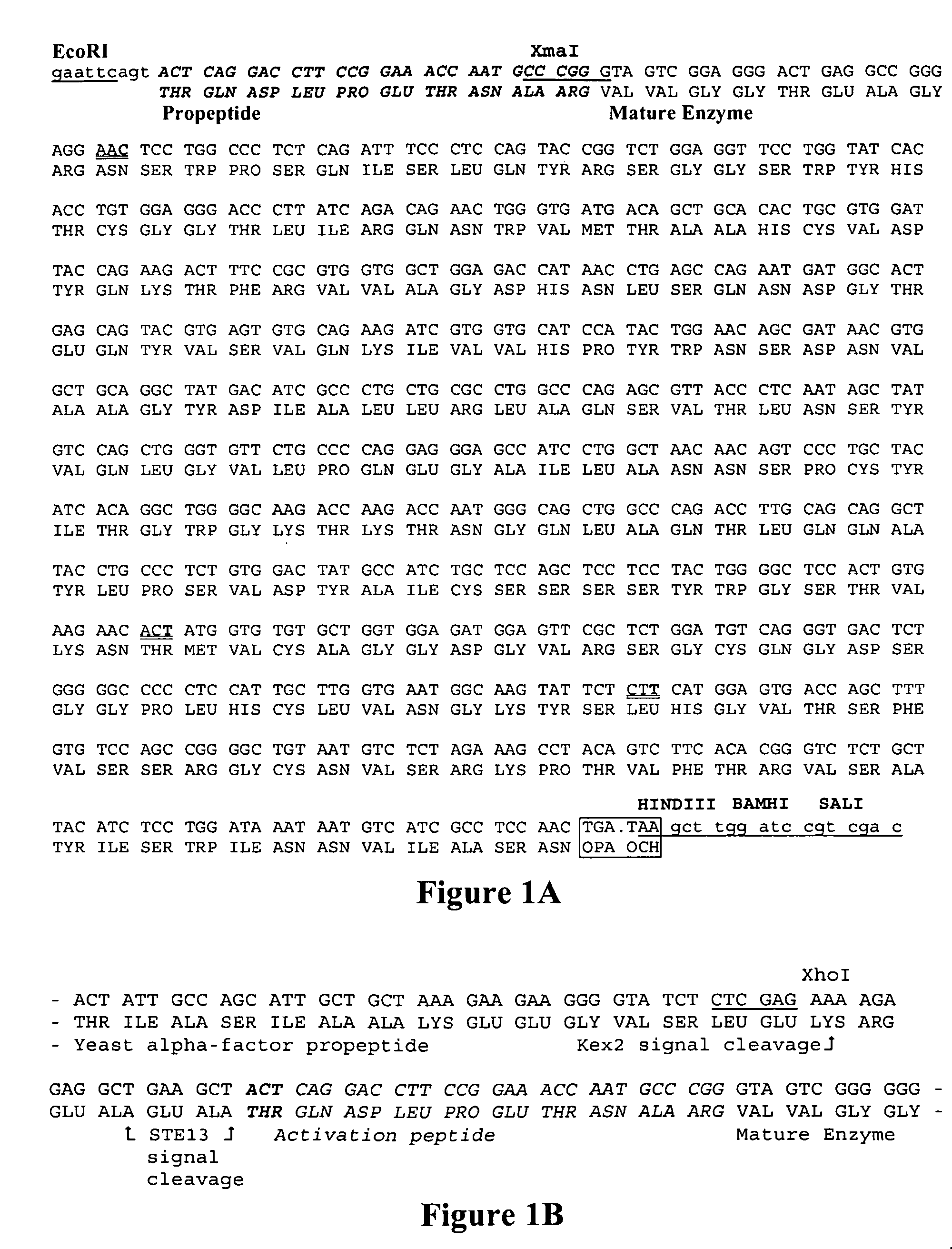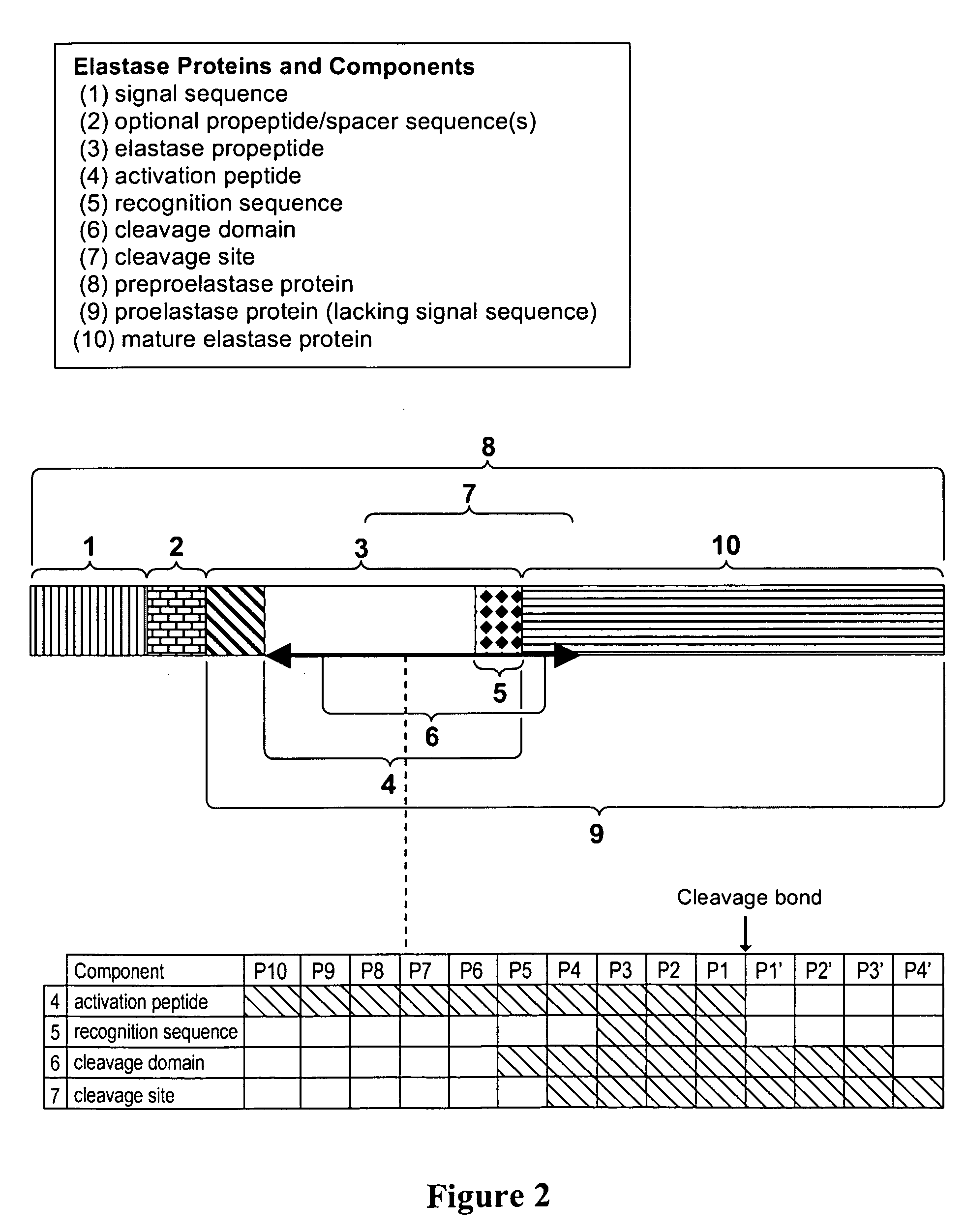Recombinant elastase proteins and methods of manufacturing and use thereof
- Summary
- Abstract
- Description
- Claims
- Application Information
AI Technical Summary
Benefits of technology
Problems solved by technology
Method used
Image
Examples
example 1
6.2 Example 1
[0356]The human elastase-1 coding sequence was obtained from U.S. Pat. No. 5,162,205 (Takiguichi et al, 1992). Several sequence changes were made to facilitate cloning into expression vectors (FIG. 1A). The base changes fell within the degeneracy of the genetic code so that no amino acid residues were changed. A second stop codon was added immediately after the native stop codon to minimize potential ribosome read through.
[0357]The modified coding sequence was synthesized by Blue Heron Biotechnology (Bothell, Wash.) using a non-PCR “long oligo” technique under license from Amgen (Thousand Oaks, Calif.). The recombinant DNA, named ELA-1.2A (SEQ ID NO: 81), was cloned into the vector Blue Heron pUC, a derivative of pUC119, and the resulting plasmid was named pPROT1. pPROT1 was sequenced on both strands to confirm the correct sequence. High quality sequencing data with extensive overlap on both strands permitted unambiguous base assignments across the...
example 2
6.3 Example 2
Expression of PRT-201 in E. coli
[0358]A variety of expression strategies were attempted in an effort to obtain soluble and enzymatically active human elastase in E. coli.
[0359]One set of E. coli expression vectors comprised in frame fusions of human type I pancreatic elastase (ELA-1) to the carboxy terminus of a Maltose Binding Protein (MBP) that was in turn fused to an N-terminal secretory peptide. Both the human ELA-1 mature and proenzyme coding sequences were cloned as in-frame C-terminal fusions to the MBP coding sequence of plasmid pMAL-p2G (New England Biolabs, Inc., Beverly, Mass.) to yield either pPROT3 (mature ELA-1) or pPROT5 (ELA-1 proenzyme). Construction of pPROT3 was effected by first obtaining by PCR mutagenesis a 6.6 kb mature human ELA-1 encoding fragment with a SnaBI site at the N-terminal valine codon of mature human ELA-1 and a HindIII site located 3′ to the mature ELA-1 termination codons. This PCR mutagenesis used a pPROT1 template comprising the...
example 3
6.4 Example 3
Expression of PRT-201 in Mammalian Cell Lines
[0364]Several expression strategies were attempted in an effort to obtain soluble and enzymatically active human type I pancreatic elastase (ELA-1) in mammalian cell lines. The high copy mammalian expression vector pcDNA3.1 (Invitrogen) containing the CMV promoter was used as a backbone for two human ELA-1 elastase expression vectors, pPROT30 and pPROT31. To construct pPROT30, the human ELA-1 proenzyme sequence was amplified by PCR and fused to a porcine pancreatic elastase signal sequence incorporated in the forward PCR primer. Using restriction sites incorporated into the PCR primers, the PCR product was digested and ligated using the corresponding restriction sites in the pcDNA3.1 vector. pPROT31 was constructed in a similar fashion, except that the human ELA-1 mature coding sequence was used instead of the proenzyme coding sequence in an attempt at direct expression of the mature enzyme. E. coli was transformed with the l...
PUM
| Property | Measurement | Unit |
|---|---|---|
| Temperature | aaaaa | aaaaa |
| Temperature | aaaaa | aaaaa |
| Temperature | aaaaa | aaaaa |
Abstract
Description
Claims
Application Information
 Login to View More
Login to View More - R&D
- Intellectual Property
- Life Sciences
- Materials
- Tech Scout
- Unparalleled Data Quality
- Higher Quality Content
- 60% Fewer Hallucinations
Browse by: Latest US Patents, China's latest patents, Technical Efficacy Thesaurus, Application Domain, Technology Topic, Popular Technical Reports.
© 2025 PatSnap. All rights reserved.Legal|Privacy policy|Modern Slavery Act Transparency Statement|Sitemap|About US| Contact US: help@patsnap.com



